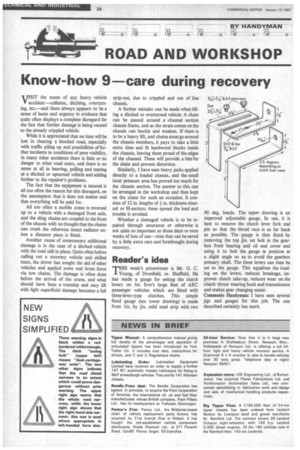Know-how 9 care during recovery
Page 40

If you've noticed an error in this article please click here to report it so we can fix it.
TISIT the scene of any heavy vehicle V accident—collision, ditching, overturning, etc.—and there always appears to be a sense of haste and urgency in evidence that quite often displays a complete disregard for the fact that further damage is being caused to the already crippled vehicle.
While it is appreciated that no time will be lost in clearing a blocked road, especially with traffic piling up and possibilities of further incidents in conditions of poor visibility, in many other accidents there is little or no danger to other road users, and there is no sense at all in heaving, pulling and tearing at a ditched or upturned vehicle and adding further to the repairer's problems.
The fact that the equipment is insured is all too often the reason for this disregard, on the assumption that it does not matter and that everything will be paid for.
All too often a mobile crane is reversed up to a vehicle with a damaged front axle, and the sling chains are coupled to the front of the chassis with no thought that the chains can crush the otherwise intact radiator unless a distance piece is fitted.
Another cause of unnecessary additional damage is in the case of a ditched vehicle with the load still in place. Quite often before calling out a recovery vehicle and skilled team, the driver has sought the aid of other vehicles and applied some real brute force via tow chains. The damage is often done before the arrival of the crane, and what should have been a tranship and easy lift with light superficial damage becomes a full strip-out, due to crippled and out of line chassis.
A further mistake can be made when lifting a ditched or overturned vehicle. A chain can be passed around a channel section chassis frame, and as the strain comes on the chassis can buckle and weaken. If there is to be a heavy lift, and chains must go around the chassis members, it pays to take a little extra time and fit hardwood blocks inside the chassis, leaving them proud of the edges of the channel. These will provide a bite for the chain and prevent distortion.
Similarly, I have seen heavy jacks applied directly to a loaded chassis, and the small local pressure area has proved too much for the chassis section. The answer to this can be arranged in the workshop and then kept on the crane for such an occasion. It consists of 12 in. lengths of 4 in. thickness channel or H-section; these spread the load and trouble is avoided.
Whether a damaged vehicle is to be repaired through insurance or otherwise is not quite so important as those days or even weeks of loss of use time that can be saved by a little extra care and forethought during recovery.
Reader's idea
'THIS week's prizewinner is Mr. G. C. 1 Young, of Dronfield, nr. Sheffield. He has made a gauge for setting the clutch levers on his firm's large fleet of AEC passenger vehicles which are fitted with three-lever-type clutches. This simple fixed gauge (see lower drawing) is made from lin. by tin. mild steel strip with two 90 deg. bends. The upper drawing is an improved adjustable gauge. In use, it is best to remove the clutch lever fork end pin so that the thrust race is as far back as possible. The gauge is then fitted by removing the top gin. set bolt in the gearbox front bearing and oil seal cover and using it to bolt the gauge in position at a slight angle so as to avoid the gearbox primary shaft. The three levers can then be set to the gauge. This equalizes the loading on the levers, reduces breakage, improves clutch take-up, reduces wear on the clutch thrust wearing bush and transmission and makes gear changing easier.
Comments Handyman: I have seen several jigs and gauges for this job. The one described certainly has merit.








































































































